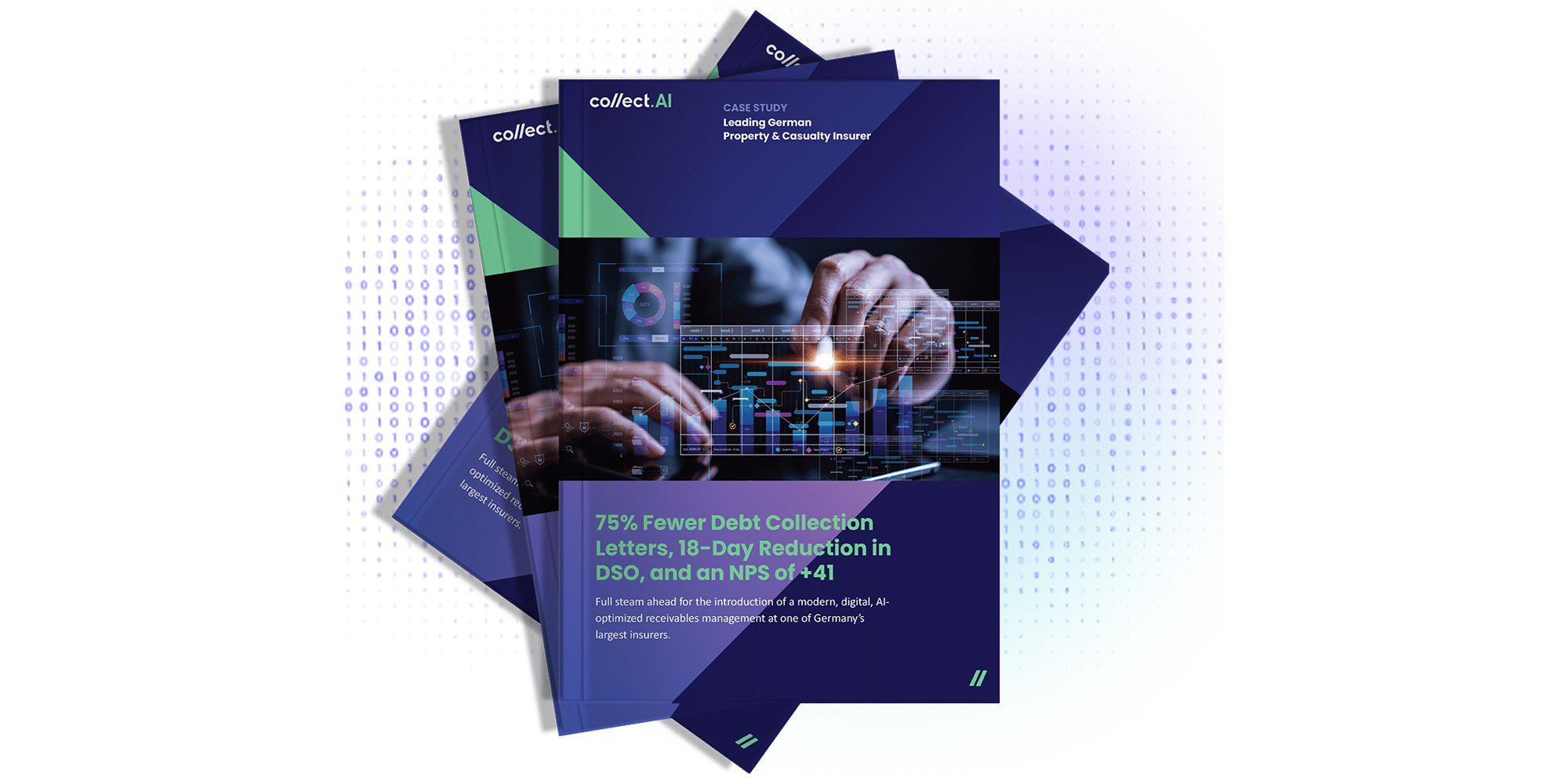
Process automation in receivables management is a crucial step for companies to maximize their revenue recognition and reduce payment disruptions and risks. With the use of artificial intelligence, these processes can be made more efficient.
Process automation in receivables management: the AI upgrade
- Increased efficiency through automated processes
- Reduction of payment disruptions and risks
- Optimization of revenue recognition
- Simplification of complex business processes
- Use of artificial intelligence to solve challenges in receivables management
Applications of AI in receivables management
The integration of artificial intelligence in receivables management opens up a panopticon of optimization possibilities. AI algorithms can analyse immense amounts of data, identify patterns and predict payment defaults in order to refine risk management and optimize payment flows. They enable a personalized approach in communication with debtors, adapted to the individual behavior and preferences of customers, in order to strengthen payment morale and accelerate the receipt of due payments. In addition, AI contributes to the automation of repetitive processes, such as the booking and reconciliation of incoming payments, which reduces administrative effort and strengthens operational excellence in debtor management.
Increased efficiency through automation of customer communication
Automated customer communication enables a more precise and faster approach that is tailored to individual customer needs. Reduced wastage and efficiency gains are immediate results
The use of machine learning enables continuous learning; the approach is always optimized. No less relevant are the time savings realized, which free up teams for strategic tasks.
Automated systems increase the payment rate by an average of 30 percent without human interventionCompanies benefit from increased responsiveness to market changes. Thanks to integrated analysis systems (predictive analytics), trends can be anticipated and communication strategies adapted. Customer satisfaction and payment behavior improve noticeably.Risk minimization and scoring optimizationIntelligent automation using AI is fundamentally transforming risk management. Sophisticated algorithms analyse customer profiles and behaviour in order to assess risks more precisely and minimize payment defaults.
Dunning process: Intelligent process control
The use of artificial intelligence in the dunning process enables debtors to be approached in an efficient and targeted manner, taking individual customer characteristics into account.
Thanks to AI, payment reminders and dunning processes are automated and personalized.
Machine learning and algorithms recognize patterns in payment behaviour and dynamically adapt communication strategies and dunning thresholds to optimize payment flows.An AI-based analysis of customer behaviour allows dunning letters to be customized and offers customers a payment option tailored to their needs, which strengthens customer loyalty and reduces the risk of default.Technological foundations of collect.AIThe technological basis of collect.AI is based on advanced machine learning processes and data analytics, which make it possible to use immense amounts of data in a targeted manner. Neuronal networks provide the capacity to recognize patterns in payment flows and make predictions about future payment behaviour. This enables adaptive control of receivables management, which is further refined through continuous learning.
The AI implemented at collect.AI is able to independently identify optimization approaches in customer communication and make real-time decisions. This technical excellence leads to automation of accounts receivable management, freeing decision-makers from repetitive tasks and freeing up resources for strategic business goals. Empowered by Big Data and Predictive Analytics, collect.AI is able to perform debtor segmentation and thus generate personalized, effective payment reminders, which increases the likelihood of timely payment receipts.
Reinforcement learning for improved payment forecasts
Reinforcement learning (RL) is a significant factor for accurate payment forecasts in receivables management.
- Individualized forecasting models - RL enables the development of customized models for different customer portfolios.
- Dynamic adaptation - Through continuous learning, the system adapts to changing payment patterns.
- Optimization of interaction strategies - Improved customer interaction through RL leads to increased success rates for payment requests.
- Risk minimization - Early detection of late or missed payments reduces potential losses.
- Cost savings - Reduction of manual effort and operational costs through automated forecasting processes.
The technology of collect.AI revolutionizes accounts receivable management through adaptive, self-learning systems.
Through the use of RL, collect.AI increases efficiency and makes dunning more precise, ultimately improving revenue performance.
Natural language interactions through natural language processing (NLP)
Natural Language Processing (NLP) forms the basis for intuitive and efficient communication in digital receivables management.
- Recognition of various requests - NLP identifies different customer concerns independently .
- Analysis of sentiment and tonality - The customer's mood is recognized and used for tailored responses
- Personalized approach - Individual communication styles increase customer acceptance .
- Automation of standard processes - Frequent inquiries are processed without human intervention. Scaling of customer support - NLP enables a large number of customer inquiries to be handled with consistent quality.
- Integration into existing systems - collect.AI offers seamless connection to existing CRM and ERP solutions.
The implementation of NLP strengthens customer trust through comprehensible and contextual communication.
Thanks to its continuous learning capability, NLP improves the quality of customer service and helps to secure sales.
Contextual Bandits & Deep-Q- Networks
Contextual Bandits and Deep-Q-Networks represent advanced machine learning methods. They enable dynamic adaptation of strategies in receivables management.
Contextual bandits are a form of reinforcement learning that optimizes decisions in real time, taking into account the respective context. This approach uses historical data patterns to maximize the probability of successful actions. Context-related variables such as payment history and behaviour are incorporated into dynamic algorithms that individualize receivables processing and thus increase success rates.Deep Q-Networks are a further development of Q-learning algorithms and use neural networks to learn the allocation of rewards. They are particularly effective in identifying optimal action strategies from a complex set of possible actions. In receivables management, this allows decisions about communication channels, tonality and timing to be made more precisely.The combination of Contextual Bandits and Deep-Q-Networks in collect.AI's platform represents a paradigm shift in receivables management. Intelligent automation processes offer increased efficiency and a refinement of the individual customer approach. Companies benefit from faster incoming payments and a strengthening of customer relationships, supported by data-driven, adaptive decision-making.Integration and adaptation into existing systems
In a disruptive market environment, flexibility in embedding advanced technologies in existing system landscapes is proving to be essential. collect.AI relies on a modular architecture that enables smooth integration and coexistence with established ERP and CRM systems. API interfaces and customization options allow the AI-based processes to fit seamlessly into the respective company workflows without forcing compromises in operational processes. This strengthens business agility and ensures a continuous, iterative optimization process.
Interfaces and data migration
Integration strength is at the heart of success
collect.AI offers a comprehensive API landscape that comprehensively facilitates data migration. This enables organizations to smoothly manage data flows between systems and ensures that all relevant information is accurately and timely transferred into the collect.AI system. Minimizing disruptions to operations and maintaining data consistency are of paramount importance here.
The connection is established using standardized protocols.Collect.AI guarantees data security and compliance - with every transfer. Advanced encryption methods and strict privacy policies ensure secure data transmission, and services are continuously adapted to the latest legal requirements. This creates trust and reduces liability risks for companies.A challenge, effectively mastered.The real-time processing of data streams by collect.AI enables an immediate response to customer interactions. The platform of collect.AI offers powerful analytical tools that analyze data as soon as it is received and provide companies with recommendations for action. This can significantly increase the efficiency of decision-making in accounts receivable management.
Adaptability to industry-specific features
Specialization is the foundation for excellence
In the highly complex structure of the various industries, it is essential to provide a customized software solution. Collect.AI ensures that AI-supported process automation provides deep insights into industry-specific processes, recognizes patterns and adapts precisely to the respective needs. In this way, subtle nuances in communication or dunning can make a decisive difference in customer perception and response.
Increased efficiency through individually configurable processes.
Context-sensitive systems are the future. Our approach at collect.AI aims not only to meet cross-industry standards, but also to support individual configurations that turn complex challenges into opportunities.
The software architecture makes it possible to integrate special features dynamically. By relying on a modular structure, collect.AI allows adjustments to be made without major operational interventions, resulting in increased agility and faster implementation of industry-specific innovations. Interfaces to special applications or data sources can be seamlessly integrated via APIs.
Measurable success and case studiesThe use of collect.AI in receivables management has enabled companies to significantly increase their rate of successful debt collection. Precise analyses, data-driven decision-making and adaptive communication strategies have led to a reduction in payment delays and defaults, as case studies show. Behavioural science findings and a personalized approach make a significant contribution to optimizing incoming payments.
In the e-commerce sector in particular, companies using collect.AI are seeing higher customer retention and an optimized cash flow structure. These improvements are reflected in increased efficiency in accounts receivable management and a better balance sheet structure.Reduction in processing times and DSOAutomation through AI systems, such as collect.AI, offers a significant minimization of operational processing times. This results in more efficient receivables processing.
The days sales outstanding (DSO) as a key indicator in financial management can be significantly reduced using intelligent algorithms. Detailed analyses enable proactive management of payment behaviour and collection processes, which shortens throughput times and optimizes working capital. This not only leads to accelerated revenue, but also increases transaction capacity without tying up additional resources.
Predictive models are used to calculate the probability of incoming payments in advance. Processes such as dunning are thus adapted dynamically and individually, which can significantly outperform traditional methods. This enables a more targeted and effective use of resources in debtor management.An optimized accounts receivable structure through AI-based systems leads to a significant reduction in DSO. This includes an in-depth analysis of payment patterns and the automatic adjustment of payment terms and conditions. Productivity in receivables management is thus increased, while at the same time the complexity of process control is reduced, which in turn enables more transparent and consistent cash flow forecasts.Case studies: Success stories and KPI improvements
Customer case studies prove the effectiveness of collect.AI.
The integration of collect.AI has enabled companies to achieve significant KPI improvements. One of these companies recorded a 47% reduction in Days Sales Outstanding (DSO) after implementing our AI-based solutions. This resulted in a significant increase in liquidity and optimization of working capital.
Our platform is achieving tangible operational success
.Another customer experienced a doubling of the rate of settled receivables while at the same time reducing receivables management costs by 30%. This illustrates the power of our AI-driven automation in receivables management.
Recent case studies show above average customer reviews in terms of user experience. The applicability of machine learning not only improves operational goals, but also promotes customer satisfaction. This is clear evidence of the added value that our technology brings to end customers on a previously unattainable scale.Frequently asked questions about process automation in receivables management
What is meant by process automation in receivables management?
Process automation in receivables management refers to the use of artificial intelligence and automated systems to optimize and automate the entire receivables management process.
What are the benefits of process automation in receivables management?
Process automation in receivables management offers numerous benefits, including improved efficiency, faster processing of receivables, a reduction in payment disruptions and risks and optimized revenue recognition.
How can process automation be implemented in receivables management?
Implementing process automation in receivables management requires the integration of artificial intelligence and automated systems into the existing receivables management infrastructure. This can be done by working with an experienced provider of process automation solutions.
What types of companies can benefit from process automation in receivables management?Companies and groups with a high volume of recurring and transactional receivables and a high need for revenue optimization and reduction of payment disruptions and risks can benefit from process automation in receivables management.
How can process automation in receivables management increase revenue?
Process automation in receivables management can increase revenue by speeding up the entire receivables process, reducing payment disruptions and optimizing revenue recognition. This allows companies to access payments faster and improve their financial performance.
What technologies are used for process automation
In the field of process automation, various technologies are used to enable more efficient and error-free processes. Some of the commonly used technologies are:
Robotic Process Automation (RPA): RPA enables the automation of repetitive tasks by using software robots to mimic human interactions with digital systems. With RPA, companies can automate routine tasks and increase efficiency.
Artificial intelligence (AI) and machine learning (ML): AI and ML are used to develop intelligent solutions that can learn and adapt. By using algorithms and machine learning, processes that require complex decisions, such as the automatic classification of documents or the prediction of payment defaults, can be automated.Process automation with workflow management systems: Workflow management systems enable the automation of business processes by defining rules and automatically exchanging information and tasks between different systems and users. These systems can seamlessly integrate and optimize processes across multiple departments and systems.
Big data and analytics: The use of big data and analytics enables companies to analyze large amounts of data and gain actionable insights. By using analytics, for example, companies can identify patterns and trends in processes in order to make better decisions and improvements.Cloud computing: By using cloud platforms, companies can automate their processes and make them scalable. Cloud-based solutions offer the opportunity to access technologies and resources without having to build an extensive internal infrastructure.
How can efficiency be increased through process automation?
Process automation can significantly increase efficiency in companies. With the automation of business processes, repetitive tasks, such as the processing of recurring and transactional receivables, can be streamlined and optimized. This leads to a reduction in manual errors and a faster workflow.
By using modern automation technology, companies can standardize and structure their processes. This enables efficient processing of large volumes of claims and reduces reliance on manual intervention. Automation also supports compliance with legal regulations and internal guidelines, as it enables consistent and traceable documentation.Another benefit of process automation is that it reduces the error rate and improves response times. Automated systems can process and analyze data in real time, which leads to faster processing of claims. By reducing manual intervention, human error is also minimized, resulting in higher accuracy and quality of work.
In addition, process automation enables a more effective use of resources. Employees can delegate time-consuming, repetitive tasks to the automation system and focus on more complex and strategic tasks. This leads to an increase in productivity and efficiency within the company.In order to benefit from the advantages of process automation, companies should rely on an integrated solution that covers various aspects of invoice and receivables management. Such a solution should be able to automatically capture, process and manage receivables while meeting compliance requirements.Conclusion: Digitalization and process optimization lead to a higher degree of automation and more productive workflowsDigitalization and process optimization play a decisive role in increasing the degree of automation and productivity of workflows. By using automation technologies, companies can simplify complex business processes and make them more efficient. This leads to a reduction in manual tasks and increased efficiency in work processing. Automation also enables improved revenue recognition and a reduction in payment disruptions and risks in receivables management. Overall, digitalization and process optimization is an important step towards increasing the degree of automation and making workflows more productive.

